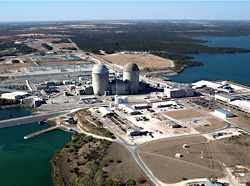This Tuesday citizens submitted a filing to the Nuclear Regulatory Commission opposing NRG’s proposed South Texas Project (STP) nuclear reactors. Petitioners included the Sustainable Energy and Economic Development (SEED) Coalition, Public Citizen and the South Texas Association for Responsible Energy.
This may sound familiar. “Didn’t citizens just file opposition to the nuke a couple weeks ago?” Well, yes they did, but that wasn’t “the” nuke, it was just one of them. Texas actually has six proposed nuclear reactors; two each at Comanche Peak (near Fort Worth), STP (by Bay City), and Victoria.
That’s right, folks, six proposed nuclear plants and 12 proposed coal plants, despite the fact that just yesterday the Chairman of the Federal Energy Regulatory Commission said that no new nuclear or coal plants may be needed in the United States, ever.
Said Karen Hadden, Executive Director of the SEED Coalition,
Our contentions laid out the many defects in the South Texas Project license application, including inadequate fire protection, the lack of viable radioactive waste disposal plan, an inability to secure against airplane attacks, vast water consumption, water contamination risks, the failure to analyze clean, safe alternatives and an array of other financial, health and safety risks.
Furthermore, STP has failed to provide cost estimates for their proposed reactors, leaving citizens with no idea of the expense they’ll be buying in to — despite the fact that one of the major partners, CPS Energy in San Antonio, is a municipal utility.
I know that when I walk in to a store and everything looks really nice but there are no price tags — I probably don’t even want to ask. The Federal Energy Regulatory Commission rates nuclear power as the most expensive form of electric generation. An analysis by Dr. Arjun Makhijani has estimated costs for the two reactors at between $12.5 – $17 billion.
Check out the press release for more information.
 This week citizens submitted two separate filings to the Nuclear Regulatory Commission (NRC) opposing Luminant (formerly TXU)’s proposed Comanche Peak nuclear reactors. Petitioners include state Rep. Lon Burnam, the
This week citizens submitted two separate filings to the Nuclear Regulatory Commission (NRC) opposing Luminant (formerly TXU)’s proposed Comanche Peak nuclear reactors. Petitioners include state Rep. Lon Burnam, the 
 In an era dubbed a “nuclear renaissance” by the nuclear industry and during which the Bush Administration has pushed one package of subsidies after another, the Nuclear Regulatory Commission (NRC) has indicated that they expect up to thirty applications to be filed to build additional nuclear plants. Currently, five or six of those proposals are moving through the complicated multi-stage process. Of these early applications, three of them (for 6 nuclear units, 2 per application) are proposed for Texas.
In an era dubbed a “nuclear renaissance” by the nuclear industry and during which the Bush Administration has pushed one package of subsidies after another, the Nuclear Regulatory Commission (NRC) has indicated that they expect up to thirty applications to be filed to build additional nuclear plants. Currently, five or six of those proposals are moving through the complicated multi-stage process. Of these early applications, three of them (for 6 nuclear units, 2 per application) are proposed for Texas.

